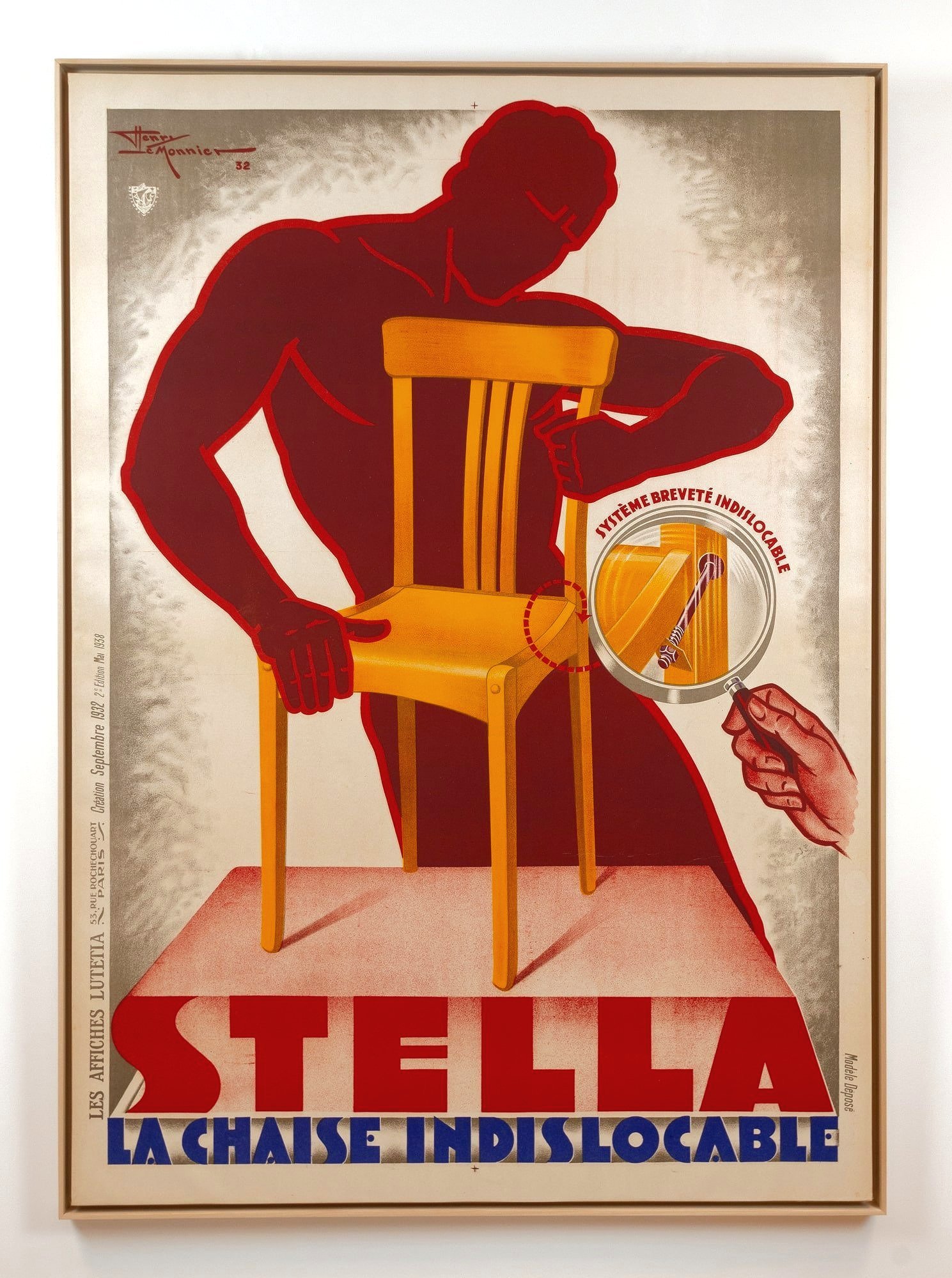Henri Lemonnier, STELLA LA CHAISE INDISLOCABLE, 1932
FEATURED POSTER
“This section features one beautiful and sought after vintage poster that I particularly like and personally speaks to me. There are so many popular subject matters when collecting posters: Airlines, travels, products, fashion, art exhibitions but what makes these items special is the emotional connection and involvement one gets at first. Collected by lovers of art, antiques, and design alike, posters feature in so many areas of daily life.”
“I have consulted expert Graphic Arts restorers - Ateliers Saint Martin - in Paris, and was told that posters needn’t be under glass as they where not initially intended for that purpose, however it is important to be displayed out of direct sunlight to prevent fading or UV damage.”
Framing is made by renowned Espace Soardi in Nice.
Henri Lemonnier, STELLA LA CHAISE INDISLOCABLE, 1932
100cm x 140cm
€ 6000
This poster presents a sculptural man trying to break a chair. The chair belongs to furniture company Stella. Lemonnier presents an unbreakable or inseparable patent system. ‘No one can dismantle Stella’s chair’. The piece is hailed for its combined eficiency, strenght and durabilty creating value for its customers. This poster was printed by Affiches Lutetia, Paris in 1938.
It is beautifuly Box Framed on stretched canvas and ready to hang.
-
Henri LeMonnier (1893–1978) created a small body of work in the field of advertising posters. He worked most notably for the printer Affiches Lutetia based in Paris. Most of his designs were created from the 1920's - 1938 and are colourful, spirited, and elegant much in the style of Leonetto Cappiello and Jean D'ylen who were more popular at that time. LeMonnier has a fine artistic hand and many of his posters are quite valuable in today's market.
Henri Le Monnier was born in Paris, France, on 7th March 1897.
Throughout his education, Le Monnier studied drawing and painting at the École Pilon and the School for Decorative Arts in Paris.
Le Monnier actively participated in creative and comic art. As a poster artist, Le Monnier worked for several printers, such as Lutecia (1923-32), Joseph Charles (1934-43), and Gaillard (1934-54). He then established a career in illustration. Le Monnier drew his first comics in the late 1940s. For instance, in his first comic art, he presented the Tarzan pages in Junior before Augusto Liquois in 1940. In the same year, Le Monnier joined Pierrot Magazine where he drew comics such as 'L'Étrange M. Ram', 'Paulix', 'Les Voyages de Gulliver' and 'Monsieur de Crac' up to 1950. Also, during this period, Le Monnier worked part-time for Belgian publisher Gordinne, where he drew for the magazine Cap’tain Sabord. He quit working on comics for magazines in 1962 and focused on illustrating tales in Total Journal up to 1965. The artist died in 1978.
This is an Original Vintage Poster; it is not a reproduction. This poster is conservation mounted, linen backed, stretched on a beautifuly framed canvas and in excellent condition.
-
1932
-
France
-
A-
Notes on Poster Condition:
Condition A
Designates a poster in virtually mint condition and because posters are delicate and printed on thin paper, very few survived the years in this state. I don't use this term very often, as I try to be conservative in my grading.
Condition A-
Designates a poster in excellent condition overall, with fine eye appeal and collectability. The colors will be extremely fresh, and the paper as well. There may be evidence of a very few short tears, and perhaps light evidence of folds. There might be a very tiny bit of margin repair, but this would be described in the listing on this website. This level of condition is extremely satisfactory for almost all collectors and I strive to have the vast majority of my inventory in this quality range. Posters in A- condition will certainly find widespread acceptance among discerning collectors.
Condition B+
Designates a poster in very good condition. There may be the tiniest fading or spotting, but in most cases the colors will be as fresh as an A-. If there is very minor restoration, it is not immediately apparent, unless searched for closely. There may be a number of tears, and only a tiny amount of paper loss. B+ posters are also highly collectable, especially if the rarer issues.
Condition B
Designates a poster in decent condition. There may be slight fading or faint stain. If there is minor restoration, it may affect a few square inches of the poster at most (ie. less than 2% of the original poster). There may be a few longer tears, and only a small amount of paper loss. Significant wrinkling or harsh folding would also put the condition of a poster at this level. Even still, a B condition poster would look attractive and impressive from a short distance away, the flaws would be only noticable at close inspection.
Condition C
Designates a poster in fair condition and moderate fading or staining may be seen. Restoration and folds may be quite pronounced, there may be some flaking of paper or minor paper loss.

